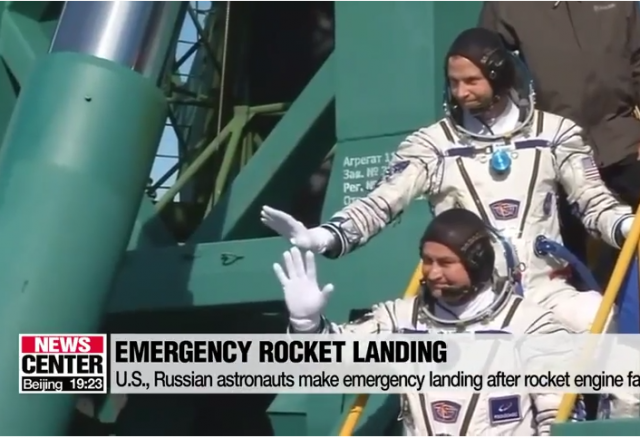U.S., Russian astronauts make emergency landing after launch failure

This October marks the 60th anniversary of the creation of the National Aeronautics and Space Administration (NASA).
However, the commemoration was almost marred by tragedy when the launch of a Russian rocket to take an American astronaut and a Russian cosmonaut to the International Space Station was forced to make an emergency landing.
NASA astronaut Nick Hague and Roscosmos’ Alexei Ovchinin lifted off as scheduled at 2:40 p.m. (0840 GMT; 4:40 a.m. EDT) Thursday from the Russia-leased Baikonur cosmodrome in Kazakhstan atop a Soyuz booster rocket. Roscosmos and NASA said the three-stage Soyuz booster suffered an emergency shutdown of its second stage. The capsule jettisoned from the booster and went into a ballistic descent, landing at a sharper than normal angle.The launch failure marks an unprecedented mishap for the Russian space program, which has been dogged by a string of launch failures and other incidents….NASA and Russian Roscosmos space agency said the astronauts were in good condition after their capsule landed about 20 kilometers (12 miles) east of the city of Dzhezkazgan in Kazakhstan.
The Russians have identified the source of the problem.
Sergei Krikalyov, the head of Roscosmos’ crewed programs, told Russian media the cause of the failure happened when one of the rocket’s four boosters failed to separate damaging the rocket’s main stage and triggering an emergency abort.”We will need to look and analyze the specific cause — whether it was a cable, a pyro or a nut,” he said. “We need more data.”A committee has been formed to determine what prevented the booster’s separation. Russian media reports that the commission was given two weeks for its investigation and expected to provide its findings before the end of the month.
There has been a human in space continuously for 18 years. The rocket failure may put an end to this record.
…Thursday’s aborted launch by a Russian rocket – one that provides astronauts’ only ride to the station – raised the risk that crews might need to abandon the $100 billion laboratory complex early next year if the rocket issue isn’t resolved quickly.The Soyuz spacecraft slated to take three Expedition 57 crew members home must depart the station by early January, unless officials waive the usual limits on how much time it can spend in orbit.If a new crew doesn’t arrive before then, the station could be left empty for the first time in nearly two decades.
Given this failure, it is fortunate that the U.S. is planning to launch astronauts from its own facilities in the near future, as “Commercial Crew Astronauts” are slated to blast off in 2019. President Donald Trump’s private-public partnership approach is perfectly timed, as it provides new options and resources for missions.
On a personal note: My family took a tour recently of the Jet Propulsion Laboratory in Pasadena, California. It was an amazing experience, as we saw the construction of a new Martian exploration vehicle and heard about the other exciting missions being planned and executed by NASA.
I sense the teams are happier to focus on scientific research and engineering discoveries than social justice. I encourage everyone with an interest in space, and who is strong enough to handle at least a little time in Southern California, arrange to take a tour. It was one of the most memorable experiences in my life.
CLICK HERE FOR FULL VERSION OF THIS STORY